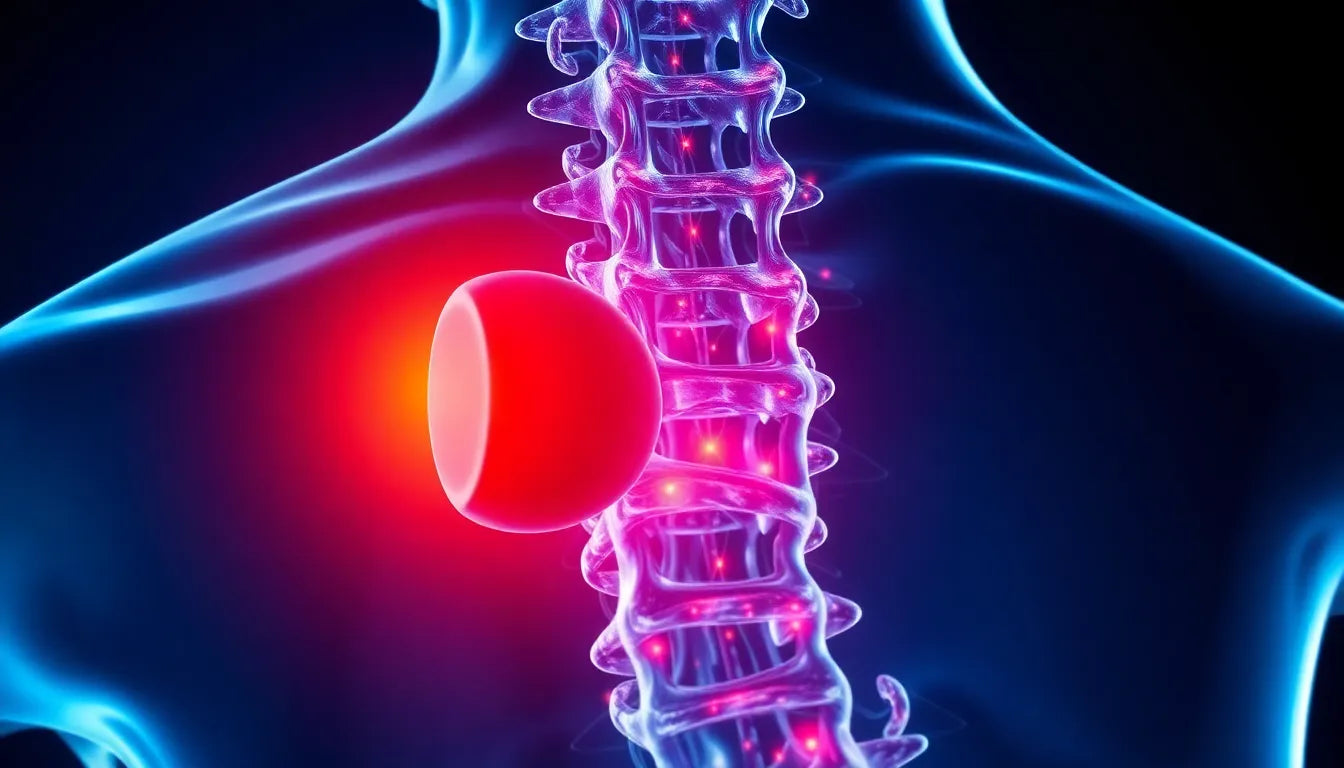Neck pain is an all-too-common complaint that many people experience but often dismiss as a minor inconvenience. However, when this discomfort is linked to a herniated disc in the neck, it can signal a more serious underlying condition that requires attention. A herniated disc in the cervical region can be a silent yet significant issue, often going unnoticed until it manifests more severe symptoms.
Understanding herniated discs in the cervical region
A herniated disc occurs when the soft inner gel of a spinal disc pushes through a tear in the tougher exterior. This condition is particularly prevalent in the cervical region, which comprises the neck's seven vertebrae. Factors such as age, injury, or degenerative disc disease can contribute to the weakening of the disc structure, making it more susceptible to herniation. Recognizing the symptoms early is crucial, as timely intervention can prevent further complications and improve quality of life.
The importance of early symptom recognition
The purpose of this blog post is to educate readers about the symptoms of a herniated disc in the neck, delve into the medical aspects of the condition, and explore treatment options. By understanding these symptoms, individuals can seek medical advice sooner, potentially avoiding more severe health issues. From mild neck pain to debilitating radiating pain, these symptoms can vary widely, making it essential to be informed and vigilant.
In the following sections, we will explore the range of symptoms associated with a herniated disc in the neck, discuss the medical and clinical aspects of the condition, and outline potential treatment options. Understanding these elements can empower individuals to take proactive steps in managing their health and well-being.
Recognizing the symptoms of a herniated disc in the neck
Identifying the symptoms of a herniated disc in the neck is crucial for seeking timely medical intervention. One of the most common signs is persistent neck pain, which can range from mild discomfort to severe, debilitating pain. This pain is often accompanied by stiffness, making it difficult to move the neck freely. The discomfort can be exacerbated by certain movements or positions, such as turning the head or lifting objects.
Understanding radiating pain and cervicobrachialgia
A herniated disc in the neck can also cause pain that radiates beyond the neck region, a condition known as cervicobrachialgia. This type of pain typically extends from the neck down to the shoulders, arms, and even the fingers. The sensation can be sharp, burning, or tingling, and it often disrupts daily activities. Individuals may find it challenging to perform tasks that require arm movement or precision, such as typing or lifting.
Weakness and sensory disturbances
Another symptom to be aware of is weakness in the shoulder, arm, or fingers. This weakness may be coupled with sensory disturbances, such as tingling, burning, or numbness. These sensations occur because the herniated disc compresses the nerves that serve these areas. If left untreated, these symptoms can lead to a decrease in muscle strength and coordination, impacting one's ability to perform everyday activities efficiently.
Severe cases and their implications
In severe cases, a herniated disc in the neck can have more widespread effects, including symptoms that affect the legs. This can lead to difficulties in walking and maintaining balance, significantly impacting mobility. Such severe symptoms indicate that the herniation is affecting the spinal cord itself, necessitating immediate medical evaluation to prevent permanent damage.
Medical and clinical aspects of cervical disc herniation
The classification of cervical disc herniation is based on the severity and location of the herniation. Symptoms can vary depending on which nerves are affected and the extent of the disc protrusion. Diagnosing a herniated disc involves a combination of physical examinations and imaging tests, such as MRI or CT scans, which provide detailed images of the cervical spine and help pinpoint the exact location of the herniation.
Impact on daily life and quality of life
The symptoms of a herniated disc in the neck can significantly interfere with daily life, affecting one's ability to work, engage in physical activities, and maintain social interactions. Chronic pain and discomfort can lead to emotional distress, reducing overall quality of life. Understanding the symptoms and seeking timely treatment can help mitigate these impacts, allowing individuals to regain control over their health and well-being.
In the next section, we will explore various treatment options available for managing herniated discs in the neck, ranging from conservative approaches to advanced medical procedures. By understanding these options, individuals can make informed decisions about their healthcare and pursue the most effective strategies for relief and recovery.
Treatment options for herniated discs in the neck
When it comes to managing a herniated disc in the neck, there are several treatment paths available, each tailored to the severity of the condition and the individual’s specific symptoms. Initial treatments often focus on conservative methods, which aim to alleviate symptoms and improve function without the need for surgery.
Conservative treatments
Conservative treatment options include physical therapy, medications, and lifestyle modifications. Physical therapy can help strengthen the neck muscles, improve flexibility, and reduce pain through targeted exercises. Medications such as non-steroidal anti-inflammatory drugs (NSAIDs) or muscle relaxants may be prescribed to manage pain and inflammation. Additionally, making lifestyle changes, such as adopting ergonomic workspaces and avoiding activities that exacerbate symptoms, can significantly impact recovery.
Advanced procedures
For those who do not respond to conservative treatments, advanced medical procedures may be considered. Minimally invasive techniques, such as endoscopic spine surgery, offer several benefits over traditional open surgery. These procedures typically involve smaller incisions, less tissue damage, and faster recovery times. Patients often experience less postoperative pain and can return to their daily activities more quickly.
Comparative analysis of treatment methods
When comparing traditional surgery to minimally invasive techniques, the latter often presents a more favorable option for suitable candidates. Minimally invasive procedures generally lead to shorter hospital stays, reduced risk of infection, and quicker rehabilitation. However, the choice of treatment should always be guided by a thorough consultation with a healthcare professional, considering the specifics of the herniation and the patient's overall health.
Preventive measures for neck health
Preventing a herniated disc in the neck involves proactive measures aimed at reducing strain and maintaining spinal health. Ergonomic adjustments at work and home can play a crucial role in preventing neck strain. This includes setting up workstations that promote good posture and using supportive chairs and desks.
Exercise and lifestyle recommendations
Regular exercise is vital for maintaining neck health and preventing disc herniation. Incorporating exercises that strengthen the neck, shoulders, and core can help support the cervical spine. Additionally, maintaining a healthy weight and avoiding smoking are lifestyle choices that contribute to overall spinal health.
Conclusion
Understanding the symptoms and treatment options for a herniated disc in the neck is essential for effective management and prevention. By recognizing early signs and adopting preventive measures, individuals can reduce the risk of severe complications and improve their quality of life. Whether through conservative treatments or advanced medical procedures, there are numerous options available to address this condition, allowing for informed decision-making and proactive health management.
Frequently Asked Questions
What are the symptoms of a herniated disc in the neck?
Common symptoms include persistent neck pain, stiffness, radiating pain to the shoulders or arms, weakness, and sensory disturbances such as tingling or numbness. In severe cases, symptoms can extend to the legs, affecting mobility.
How is a herniated cervical disc diagnosed?
Diagnosis typically involves a combination of physical examinations and imaging tests like MRI or CT scans, which help identify the location and severity of the herniation.
What are the treatment options for a herniated disc in the neck?
Treatment options range from conservative methods, such as physical therapy and medications, to advanced procedures like minimally invasive surgery, depending on the severity of the condition.
Can lifestyle changes help prevent a herniated disc?
Yes, lifestyle changes such as maintaining good posture, engaging in regular exercise, and making ergonomic adjustments can help prevent neck strain and reduce the risk of disc herniation.
When should I see a doctor for neck pain?
It is advisable to consult a healthcare professional if neck pain persists, worsens, or is accompanied by symptoms like radiating pain, weakness, or numbness, as these may indicate a more serious condition such as a herniated disc.
Sources
- Spine-Health. (2023). "Cervical Herniated Disc Symptoms and Treatment Options."
- Rhee, J. M., & Yoon, T. (2015). "Cervical Disc Herniation: Clinical and Radiological Aspects." Journal of Clinical Orthopaedics.
- Mayo Clinic. (2023). "Herniated Disk: Symptoms and Causes."
- Orthobullets. (2023). "Cervical Disc Herniation."
- Dr. Smith, M. (2023). "Minimally Invasive Spine Surgery for Cervical Herniated Disc." YouTube.


















